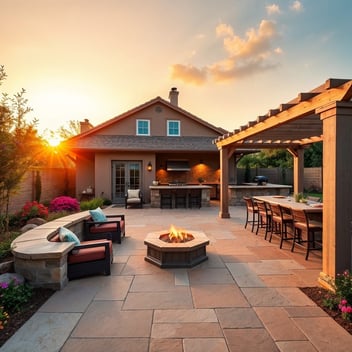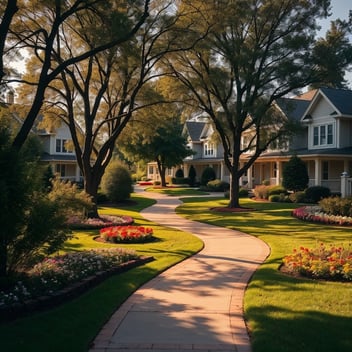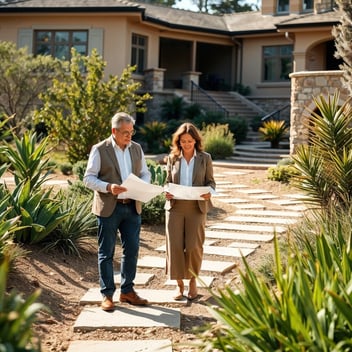The Role of Color in Landscape Design: A Master Designer's Guide

Introduction: Why Color Matters in Landscape Design
After spending 25 years transforming countless Long Island properties into vibrant outdoor sanctuaries, I've learned that color is more than just an aesthetic choice—it's the secret language of landscape design. When we talk about creating emotional connections with outdoor spaces, color leads the conversation. Today, I'm excited to share my expertise on how to harness the power of color to transform your landscape into a masterpiece that speaks to your soul and elevates your property's value.
Whether you're planning to revamp your home's exterior or seeking inspiration for a commercial property, understanding color in landscape design will help you make informed decisions that yield stunning results. Let's dive into the fascinating world of color theory and its practical applications in landscape design.
Understanding Color Theory in Landscape Design
Before we delve into specific applications, let's establish a foundation in color theory. In my years designing award-winning gardens in the Hamptons, I've discovered that understanding these principles is crucial for creating harmonious outdoor spaces.
The Color Wheel: Your Blueprint for Success
Think of the color wheel as your landscape design compass. It guides you through:
- Primary Colors (Red, Blue, Yellow): These are your foundation colors, often seen in bold flowering plants like red salvias, blue delphiniums, and yellow daylilies. I've found that using these colors as focal points can create powerful visual anchors in your landscape, especially when designing show-stopping entrance gardens.
- Secondary Colors (Green, Orange, Purple): Created by mixing primary colors, these offer wonderful opportunities for creating depth and interest. For instance, purple coneflowers paired with orange lantana create a striking contrast that catches the eye while maintaining harmony.
- Tertiary Colors: These subtle variations, like blue-green or yellow-orange, provide the nuanced transitions that make a landscape design feel sophisticated and well-planned. They're particularly effective in creating gradual color transitions in larger landscapes.
Color Relationships That Work
Understanding color relationships has been crucial in my approach to modern landscape architecture trends. Here are the key relationships to consider:
- Complementary Colors: Located opposite each other on the color wheel, these create dynamic contrasts. Picture deep purple irises against chartreuse hostas—a combination I've used countless times to create eye-catching garden moments. This contrast isn't just about visual appeal; it's about creating spaces that command attention and remain memorable.
- Analogous Colors: These are colors that sit next to each other on the color wheel. They create peaceful, harmonious combinations that work beautifully in meditation gardens or quiet seating areas. For example, a progression of blues, purples, and pinks can create a serene atmosphere perfect for unwinding after a long day.
- Monochromatic Schemes: Using variations of a single color creates sophisticated, elegant designs. I often employ this technique in formal gardens, using different shades of green through various textures and plant forms to create depth and interest without color complexity.
Seasonal Color Planning: The Key to Year-Round Interest
One of the biggest challenges in landscape design is maintaining visual interest throughout the year. This is where strategic color planning becomes essential, especially when incorporating native plants in your design.
Spring: The Season of Awakening
- Early Spring Colors: Focus on soft pastels that mirror nature's awakening. Think pink cherry blossoms, yellow daffodils, and purple crocuses. I often layer these early bloomers to create waves of color that emerge as the season progresses, providing continuous interest as your landscape comes to life.
- Late Spring Palette: As the season advances, introduce stronger colors through tulips, azaleas, and rhododendrons. This is your chance to create bold statements that announce the arrival of the growing season. Consider incorporating flowering trees that provide both color and structure to your design.
Summer: Peak Color Performance
- Hot Color Combinations: Summer is the time to embrace bold, warm colors. Combine fiery reds, sunny yellows, and vibrant oranges in your perennial beds. I've found that incorporating heat-loving plants like black-eyed susans, bee balm, and coneflowers creates reliable color shows that persist through the hottest months.
- Cool Retreat Areas: Balance intense summer colors with cooling blues, purples, and whites in shaded retreat areas. This creates visual temperature changes in your landscape that can make hot summer days feel more comfortable. Consider plants like hydrangeas, which offer long-lasting blooms and can be influenced to produce different colors based on soil pH.
Fall: Nature's Grand Finale
- Planned Color Transitions: Select plants and trees that provide spectacular fall color. Japanese maples, burning bushes, and oakleaf hydrangeas offer reliable autumn displays. The key is layering these elements so the color change occurs gradually, extending the season's visual interest.
- Late Season Bloomers: Incorporate plants like asters, chrysanthemums, and sedum to provide fresh color when other plants are fading. These late-season performers help maintain visual interest well into autumn while complementing the changing foliage colors.
Winter: Finding Color in Unexpected Places
- Evergreen Foundation: Create a strong backbone of evergreens in various shades, from deep green to blue-tinged varieties. This provides year-round structure and color even in the depths of winter. Consider varieties like blue spruce or gold-tinted cypress for added winter interest.
- Winter Interest Plants: Include plants with colorful bark (red-twig dogwood), persistent berries (winterberry holly), or interesting seed heads (ornamental grasses) for winter color and texture. These elements become especially striking against a snowy backdrop.
Color Psychology in Landscape Design
Understanding the psychological impact of color has been crucial in creating functional outdoor spaces that not only look beautiful but also feel right. Here's how different colors affect mood and perception:
Warm Colors: Creating Energy and Excitement
- Red: The color of passion and energy, red draws attention and creates focal points in the landscape. I use it sparingly but effectively in areas where I want to direct attention or create excitement. Consider using red in entrance gardens or gathering spaces where you want to stimulate conversation and activity.
- Orange: This friendly, sociable color works wonderfully in entertainment areas and children's gardens. It combines the energy of red with the cheerfulness of yellow, making it perfect for spaces where you want to encourage social interaction and playfulness.
- Yellow: The color of sunshine and happiness, yellow can brighten shady areas and create welcoming spaces. I often use yellow flowers or foliage to illuminate darker corners of gardens or to create cheerful container arrangements near entryways.
Cool Colors: Promoting Relaxation and Tranquility
- Blue: The most calming color in the landscape, blue creates a sense of depth and tranquility. I frequently use blue flowers and foliage in meditation gardens or quiet seating areas where relaxation is the primary goal. Blue also has the unique ability to make spaces appear larger due to its receding quality.
- Purple: Associated with luxury and sophistication, purple adds a touch of elegance to any garden design. It works beautifully in formal gardens and can create a sense of mystery and depth when used in layers with other cool colors.
- Green: The dominant color in most landscapes, green serves as a neutral backdrop that can be either energizing or calming depending on its intensity and how it's used. Various shades of green create depth and texture while providing a restful environment for the eyes.
Practical Applications and Design Strategies
Creating Color Schemes for Different Property Types
- Residential Properties: For home landscapes, I recommend starting with colors that complement your home's exterior. Consider your personal color preferences but also think about how the colors will look from both inside and outside your home. The view from your windows should be as carefully planned as the curb appeal.
- Commercial Properties: Commercial landscapes often benefit from bold, attention-grabbing color schemes that reflect brand identity while maintaining professional appeal. The key is creating memorable displays that remain tasteful and appropriate for the business environment.
- Public Spaces: When designing for public areas, focus on durable plants that provide consistent color through the seasons. Consider using color to guide movement through the space and create distinct areas for different activities.
Color in Hardscape Elements
- Paving Materials: The color of walkways, patios, and driveways plays a crucial role in the overall color scheme. I often use warmer-toned pavers to create welcoming pathways and cooler tones for areas where I want to create a sense of calm and sophistication.
- Built Structures: Consider how architectural elements like pergolas, fences, and walls contribute to your color palette. These elements can either complement or contrast with your plantings to create visual interest.
- Furniture and Accessories: Garden furniture, containers, and decorative elements provide opportunities to introduce seasonal color changes and create cohesive design themes throughout your landscape.
Lighting and Color
- Natural Light Variations: Consider how colors appear in different light conditions. Morning and evening light can dramatically change how colors are perceived. I always recommend viewing plant combinations at different times of day before making final decisions.
- Artificial Lighting: Strategic landscape lighting can enhance or alter color perceptions after dark. Use lighting to highlight specific color features and create dramatic nighttime effects that extend your landscape's visual impact into the evening hours.
Common Color Mistakes and How to Avoid Them
- Overcrowding Colors: One of the most common mistakes I see is trying to include too many colors in a single space. Instead, focus on a limited palette and use repetition to create rhythm and cohesion throughout your landscape. This approach creates more sophisticated and visually pleasing results.
- Ignoring Seasonal Changes: Your landscape should be designed with all seasons in mind. Plan for succession planting where one group of plants takes over as another fades. This requires careful consideration of bloom times and foliage changes throughout the year.
- Forgetting About Foliage: While flowers provide spectacular color displays, they're often temporary. Don't overlook the importance of foliage colors in creating lasting interest. Mix plants with different leaf colors, textures, and shapes for year-round appeal.
Maintenance Considerations for Color-Rich Landscapes
- Deadheading and Pruning: Regular maintenance is crucial for maintaining vibrant color displays. Establish a routine for deadheading spent blooms and pruning to encourage repeat flowering and maintain plant health. This ongoing care ensures your color scheme remains fresh and impactful throughout the growing season.
- Soil Health and Nutrition: Different colors in plants often require specific soil conditions to thrive. For example, hydrangea colors can be influenced by soil pH. Understanding and maintaining proper soil conditions is essential for preserving your desired color scheme.
- Succession Planting: Plan and implement a succession planting strategy to ensure continuous color throughout the growing season. This might involve interplanting spring bulbs with later-blooming perennials or using annuals to fill gaps between perennial bloom times.
Conclusion: Bringing Your Color Vision to Life
Color in landscape design is both an art and a science. It requires careful planning, an understanding of plant behavior, and a vision for how different elements will work together throughout the seasons. Whether you're planning a complete landscape renovation or simply want to add more color to your existing garden, remember that successful color design starts with a solid plan and evolves through careful observation and adjustment.
Ready to transform your outdoor space with a professionally designed color scheme? Working with an experienced landscape designer can help you avoid common pitfalls and create a color palette that brings your vision to life while ensuring year-round interest and sustainable beauty.



